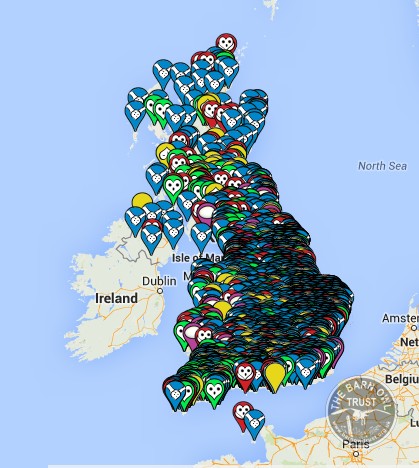Barn Owl surveys
UK online Barn Owl survey
Our UK online Barn Owl Survey website provides non-stop data collection and up-to-date maps showing Barn Owl distribution across the entire UK. With help from BBC Springwatch over 2,800 people provided over 4,000 Barn Owl sightings (including roost sites and nest sites) in the website’s first 18 months.
County Barn Owl surveys
The most intensively surveyed areas in the whole of the UK are Devon (where we are based) and Cornwall. Devon has had 3 Barn Owl surveys (1 every 10 years) and
Cornwall has had 2. These surveys consist of rechecking all the sites where Barn Owls have been recorded roosting or nesting in the previous 10 years. They also serve as a vital population health-check, enabling us to identify sites under threat and target future conservation work to where it is most needed.
After the second Devon survey, we were able to quantify changes in the number of known roost and nest sites in each local authority district as an aid to assessing the usefulness of the District Barn Owl Schemes we had carried out. Fortunately the results showed that the county population estimate had gone up by 37% and that most of the increase was in the areas where we’d done most of our conservation work!
Just to give you some idea of the scale of these surveys, during the last Devon Barn Owl Survey we checked 1,234 sites!
For free, downloadable full County Survey Reports and other research projects take a look at our publications page.
Pre-development and planning surveys
We have completed a number of Barn Owl survey contracts for local authorities and private developers. For example, a survey of the route of the A30 dual carriageway was conducted on behalf of the Department of Transport, both before construction began and again 3 years after the road was opened. This formed part of the evidence base presented in our report ‘Barn Owls and Major Roads: results and recommendations from a 15-year research project’.
Professional Barn Owl surveys and survey training
Many planning and pre-development survey contracts (e.g. barn conversions) require multiple-species wildlife surveys and these are mainly conducted by independent ecological consultants. Our input into such surveys is mainly through the training courses we provide. Since 2005 we have trained over 700 ecological consultants to survey sites for Barn Owls, create strategies for mitigation and enhancement, and make appropriate recommendations in their Site Survey Reports. To find a BOT-trained consultant in your area please visit our Barn Owl Directory.
Do-it-yourself surveys
Surveying areas for Barn Owls is a fantastic way of starting your own Barn Owl project. This is how our own work began back in 1984! If you want to maintain or increase the number of Barn Owls in an area it makes good sense to find out how many there are in the first place. As counting individuals is almost impossible, the number of known nests is generally taken to indicate the minimum number of pairs. Surveyors need to know where to search (i.e. know the sort of places a Barn Owl may be nesting or roosting) and be able to identify species and age-determine signs of occupation such as pellets, feathers and nest debris.
Whether you’re a complete beginner or a professional, all of the information you need to get started surveying for Barn Owls is in the Barn Owl Conservation Handbook.
Please note:
- Barn Owl surveys in preparation for a planning application need to be carried out by a ‘suitably qualified person‘ which generally excludes amateurs.
- The possibility of disturbing nesting Barn Owls has legal implications that should be considered.
Other relevant pages
- Current Barn Owl population
- Most owls heard in the UK are not Barn Owls. Identify the owls you see and hear with our owl identification page
- You can learn to survey sites for Barn Owls by attending our training course
- There’s lots of information on surveying Barn Owls in the Barn Owl Conservation Handbook




